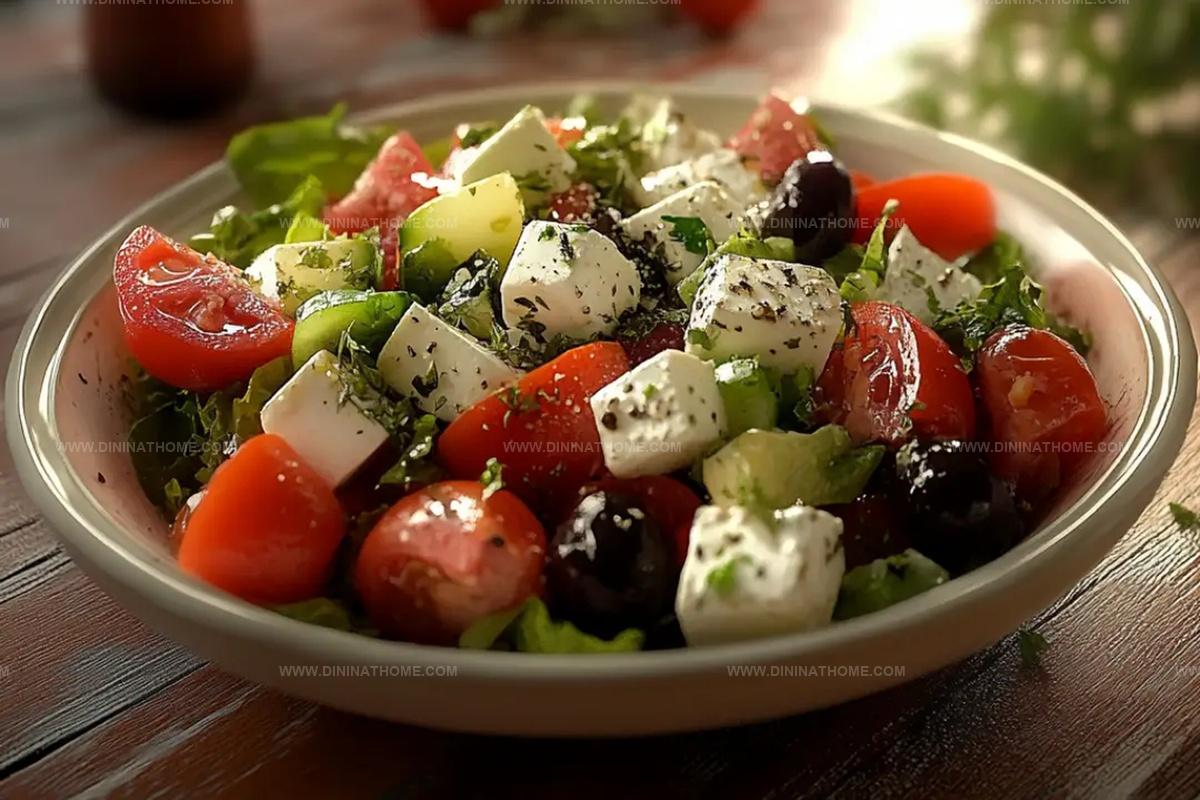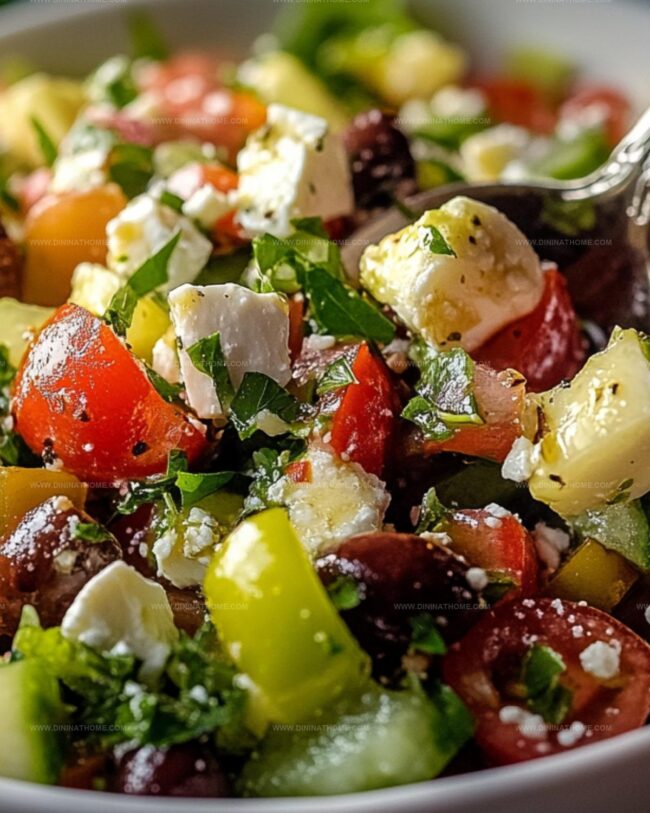Refreshing Classic Greek Salad Recipe for Sunny Days
Mediterranean summers burst with vibrant salad flavors that capture classic greek salad’s authentic spirit.
Crisp cucumber slices and juicy tomatoes dance across rustic plates.
Briny kalamata olives add depth to each refreshing bite.
Feta cheese crumbles bring tangy richness that makes this dish irresistible.
Salt-kissed ingredients whisper stories of sunny coastlines and relaxed dining.
Crunch meets creaminess in a symphony of simple, fresh components.
Let this recipe transport you to a charming Greek taverna with just a few ingredients.
Greek Salad That’s Refreshing And Loved By All Ages
Classic Greek Salad What Goes In
Fresh Vegetables:Cheese and Olives:Dressing and Seasoning:Optional Garnish:How to Build a Crisp & Fresh Greek Salad
Step 1: Chop Fresh Produce
Grab your cutting board and knife.
Slice ripe tomatoes into chunky wedges.
Dice crisp cucumber into bite-sized pieces.
Thinly slice red onion.
Cut green bell pepper into small chunks.
Transfer all chopped vegetables into a spacious mixing bowl.
Step 2: Scatter Mediterranean Treasures
Sprinkle Kalamata olives generously over the vegetable mixture.
Place a whole block of creamy feta cheese on top or crumble it for easier serving.
The cheese should sit beautifully atop the colorful vegetables.
Step 3: Whip Up Zesty Dressing
In a separate small bowl, combine:Whisk these ingredients together until they create a smooth, aromatic mixture.
Taste and adjust seasonings as needed.
Step 4: Dress and Toss
Gently pour the dressing over the salad.
Use a light touch to distribute the liquid, ensuring each vegetable gets a delicate coating.
Be careful not to break the feta cheese while mixing.
Step 5: Finish with Herbal Flourish
Sprinkle fresh chopped parsley or extra oregano on top for a burst of color and additional flavor.
Serve immediately alongside warm pita bread or as a refreshing side to grilled proteins.
Salad Building Tricks for a Classic Greek Bowl
Store Classic Greek Salad Properly
Fresh Pairings for Classic Greek Salad
Salad Swaps for a Greek-Inspired Touch
FAQs
The key ingredients are fresh tomatoes, cucumber, red onion, green bell pepper, Kalamata olives, feta cheese, olive oil, red wine vinegar, dried oregano, salt, and pepper.
Yes, feta cheese is essential and a defining ingredient in a traditional Greek salad. It provides a tangy, creamy element that distinguishes this salad from other Mediterranean salads.
It’s best to prepare the Greek salad just before serving to keep the vegetables crisp and fresh. If needed, you can chop vegetables in advance and store separately, then combine and dress just before eating.
Extra virgin olive oil is recommended for authentic flavor. Greek olive oil is ideal, but a good quality extra virgin olive oil from any region will work well in the recipe.
Print
Classic Greek Salad Recipe
- Total Time: 15 minutes
- Yield: 4 1x
Description
Crisp Mediterranean flavors dance through this classic greek salad, blending fresh cucumbers, juicy tomatoes, and tangy feta cheese. Mediterranean herbs and olive oil unite to create a refreshing dish that transports you to sunny Greek shores with each delightful bite.
Ingredients
Main Ingredients:
- 3 ripe tomatoes, chopped into wedges
- 1 cucumber, sliced (or quartered if using a large cucumber)
- 8 ounces (226 grams) block of feta cheese, cut into cubes or crumbled
- 1/2 cup Kalamata olives, pitted
Vegetable Additions:
- 1 small red onion, thinly sliced
- 1 green bell pepper, sliced
Dressing and Seasoning:
- 2 tablespoons (30 milliliters) extra virgin olive oil
- 1 tablespoon (15 milliliters) red wine vinegar
- 1 teaspoon dried oregano
- Salt and pepper, to taste
Optional Garnish:
- Fresh parsley or oregano
Instructions
- Chop the fresh, ripe tomatoes into bite-sized cubes, slice crisp cucumber into half-moons, thinly slice red onion, and dice green bell pepper into uniform pieces.
- Transfer all chopped vegetables into a spacious mixing bowl, creating a vibrant Mediterranean medley.
- Carefully distribute Kalamata olives across the vegetable landscape, then position the feta cheese block prominently on top, maintaining the traditional Greek presentation.
- Craft the dressing by whisking extra virgin olive oil with robust red wine vinegar, sprinkling dried oregano, and seasoning with sea salt and freshly ground black pepper.
- Gently cascade the aromatic dressing over the salad, allowing it to delicately coat each vegetable piece without overwhelming the ingredients.
- Optional: Briefly toss the salad to integrate flavors, taking care not to disrupt the feta’s elegant whole-block appearance.
- Enhance the visual appeal by garnishing with fresh parsley or an extra pinch of oregano, adding a final touch of herbaceous brightness.
- Serve immediately alongside warm, soft pita bread or as a complementary side to grilled Mediterranean proteins, capturing the essence of Greek culinary tradition.
Notes
- Chop vegetables uniformly to ensure balanced flavor and consistent bite in every forkful.
- Swap feta with plant-based alternatives like tofu or vegan cheese for dairy-free diets without compromising authentic Greek flavor profile.
- Select high-quality Kalamata olives from specialty stores for richer, more authentic Mediterranean taste experience.
- Adjust vinegar and oil ratio based on personal preference, keeping traditional proportions for authentic Greek salad character.
- Prep Time: 15 minutes
- Cook Time: 0 minutes
- Category: Lunch, Appetizer, Snacks
- Method: None
- Cuisine: Greek
Nutrition
- Serving Size: 4
- Calories: 150
- Sugar: 3 g
- Sodium: 800 mg
- Fat: 12 g
- Saturated Fat: 4 g
- Unsaturated Fat: 8 g
- Trans Fat: 0 g
- Carbohydrates: 10 g
- Fiber: 2 g
- Protein: 5 g
- Cholesterol: 20 mg





James Walker
Lead Recipe Developer & Culinary Educator
Expertise
Southern Cuisine & Farm-to-Table Cooking, Recipe Development & Testing, Culinary Education & Instruction
Education
School: Auguste Escoffier School of Culinary Arts
Program: Diploma in Culinary Arts and Operations
Focus: Comprehensive training in classical and modern culinary techniques, kitchen operations, and farm-to-table practices.
James didn’t learn cooking from a TV show, he learned it from busy kitchens, family gatherings, and long afternoons spent testing recipes the hard way.
After training at the Auguste Escoffier School of Culinary Arts, he brought his love for real, down-to-earth food to every dish he makes.
At Dining At Home, James loves building recipes that feel familiar but still have something special, like adding a twist to a classic or making a slow Sunday dinner feel brand new.
When he’s not in the kitchen, you’ll probably find him swapping garden tips at the farmers’ market or teaching his daughter how to flip pancakes without a mess (almost).